இந்த ஒட்டுண்ணி மோசமான நோயை மனிதர்களுக்கு ஏற்படுத்தலாம் என்ற எச்சரிக்கையை விஞ்ஞானிகள் விடுத்துள்ளார்கள். பிரித்தானியாவில் வருடத்திற்கு 3500 இறப்புக்கள் இந்த மூளைப் புற்றுநோயால் ஏற்படுகின்றன என தெரியவந்துள்ளது. ரொக்சோபிளாஸ்மா கொன்டி(Toxoplasma gondii) எனும் இந்த ஒட்டுண்ணியானது உலகத்தில் உள்ள மனிதர்களில் மூன்று பங்கினரால் மூளைகளின் ஆழத்திலே காவிச்செல்லப்படுகின்றன. இதுவே மனிதர்களுக்கு மட்டுமல்லாது மிருகங்களிலும் மனநிலையில் மாற்றங்களை ஏற்படுத்துகின்றது. பிரித்தானிய மக்களில் 34 வீதத்தினரை இது தாக்குவதுடன் வாழ்க்கைமுறையையும் சிக்கலானதாக்குகின்றது. ஆனால் இது பூனைகளுக்குள்ளேயே வாழ்கின்றதுடன் தமது நுண்ணிய முட்டைகள் மூலம் கிருமித்தொற்றையும் ஏற்படுத்துகின்றது. கர்ப்பமாயுள்ள பெண்கள் பூனைகள் உண்ட தட்டைத் துப்புரவு செய்யக்கூடாதென்று ஏற்கனவே எச்சரிக்கப்பட்டுள்ளனர். இது பிறக்கப்போகும் குழந்தைக்கு ஆபத்தை ஏற்படுத்தலாம். இப்போது ஏனையவர்களுக்கும் இந்த எச்சரிக்கை விடுக்கப்பட்டுள்ளது. பிரெஞ்சு விஞ்ஞானிகள் ஆண்களிலும் பெண்களிலும் உள்ள மூளைப் புற்றுநோயின் தரவுகளைச் சேமித்தனர். அதனைப் பின்னர் T.dondii கிருமித்தாக்க வீதத்துடன் ஒப்பிட்டுப்பார்த்தனர். ஒட்டுண்ணிகள் கூடுதலாகக் காணப்படும் நாடுகளில் இந்த மூளைப் புற்றுநோய் அதிகளவில் காணப்பட்டதாக இந்தத் தரவு குறிப்பிட்டது. இந்த ஒட்டுண்ணியால் ஒருவரது செயற்பாடும் மாற்றமடையலாம். எலிகளில் செய்யப்பட்ட ஆய்வின் போது இவை பூனைக்குப் பயப்படும் தன்மையிலிருந்து மாறியிருந்தன. இதுபோலவே மனிதர்களுக்கும் ஏற்படலாம். அவை ஆண்களை மூர்க்கமானவர்களாகவும் பொறாமை மிக்கவர்களாகவும் மாற்றுவதோடு பெண்களைப் பாலியல் ரீதியில் அதிக ஆர்வங்கொள்ள வைப்பதாகவும் மாற்றிவிடுமென ஆய்வுகள் தெரிவிக்கின்றன. மனிதர்களில் ஏற்படும் கிருமித்தொற்றுக்கள் கூடுதலாக நன்றாகச் சமைக்காத ஆட்டிறைச்சி, பன்றியிறைச்சி, மானிறைச்சி போன்றவற்றாலும் பூனையின் கழிவினால் தொற்றாக்கப்பட்ட நீரை, மண்ணை அல்லது எந்த உணவினையும் உட்கொள்வதாலும் ஏற்படுத்தப்படலாம். மூளைப் புற்றுநோயைப் பூனைகள் பரப்புகின்றனவெனத் தாங்கள் இன்னும் நிரூபிக்கவில்லை என்றும் இந்த ஆய்வில் கூறியுள்ளனர். இதற்கு மேலும் ஆய்வுகள் மேற்கொள்ளப்பட வேண்டும் என இவர்கள் குறிப்பிட்டுள்ளனர். T.dondii ஒட்டுண்ணிக்கும் மூளைப் புற்றுநோய்க்குமிடையிலுள்ள தொடர்பை அறிவதன் மூலம் புற்றுநோய்க்கான ஆபத்தைக் குறைப்பதற்கான முக்கிய வழிகளைக் கண்டுபிடிக்கும் வழி கிடைக்கும் என விஞ்ஞானிகள் நம்பிக்கை தெரிவித்துள்ளனர் |
Search This Blog
Monday, August 1, 2011
பூனைகளால் மனிதர்களுக்கு மூளை புற்றுநோய் ஏற்படலாம்: விஞ்ஞானிகள் தகவல்
The Root of Fortune
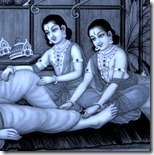 “In Kali Yuga, Shri Rama’s holy name is like a desire tree, devotion to Him is like a heavenly cow, and the dust from the lotus feet of the guru is the root of all good fortunes and auspiciousness.” (Dohavali, 27)
“In Kali Yuga, Shri Rama’s holy name is like a desire tree, devotion to Him is like a heavenly cow, and the dust from the lotus feet of the guru is the root of all good fortunes and auspiciousness.” (Dohavali, 27)rāma nāma kali kāmatarū rāma bhagati suradhenu |
sakala sumangala mūla jaga gurūpada paṃkaja renu ||
sakala sumangala mūla jaga gurūpada paṃkaja renu ||
Because of how the mind operates, complacency can set in regardless of the circumstance. We may have been in trouble during a previous time and been appreciative of the ensuing rescue, but after some time the mind starts to take for granted what it has. This is especially true with those objects which constantly supply us benedictions. The rain pours down its water in the middle of the night onto the field so that no one is bothered, but in the morning the farmer can only think that it has not rained enough, for he is always anxious about his next harvest and whether or not he will be able to eke out a living. The trees that constantly produce fruits for us to enjoy and the cows that provide us the milk that turns into many other preparations are the sources of supreme welfare in this world, but even they have a root cause, a sustainer of life. When the origin of all fortunes is remembered, honored, respected and never taken for granted, life’s necessities can be acquired without a problem.
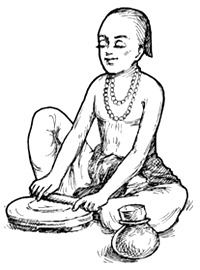 In the above quoted verse from his Dohavali, Goswami Tulsidas brilliantly paints the complete picture for how anyone can find full auspiciousness in life, even those who are trapped in the dark age of Kali, the present time period marked by rampant hypocrisy and quarrel. Even if a person is inclined towards piety, virtue, spirituality and helping others to find happiness, in Kali Yuga they will be vilified for being outdated, stuck in the past on traditions that have lost their value. Man is more evolved now, don’t you see? He has learned how to become a slave to machinery and quick delights in lieu of building a better foundation for the future of the soul.
In the above quoted verse from his Dohavali, Goswami Tulsidas brilliantly paints the complete picture for how anyone can find full auspiciousness in life, even those who are trapped in the dark age of Kali, the present time period marked by rampant hypocrisy and quarrel. Even if a person is inclined towards piety, virtue, spirituality and helping others to find happiness, in Kali Yuga they will be vilified for being outdated, stuck in the past on traditions that have lost their value. Man is more evolved now, don’t you see? He has learned how to become a slave to machinery and quick delights in lieu of building a better foundation for the future of the soul.The forces blocking the proper education of the populace at large is just one aspect of Kali’s magic. There is also the issue of personal practice. Abiding by religious principles, irrespective of which particular faith they belong to, is very difficult, especially given the constant allures that attack the psyche and try to persuade the mind to abandon the ultimate reservoir of pleasure, the Supreme Person whom every individual is naturally inclined to serve. Due to the many impediments, there is a shortcut process for the people of this age that brings all auspiciousness and every desire imaginable, but in a purified form. Though this practice is not hard to implement and become attached to, taking the first steps is difficult. With any new task, the believability of the promises made by their champions is always in doubt, thus making it difficult to take to any new engagement with sincerity. Yet there is no reason to doubt that this singular method of salvation for the people of this age proves effective in every way.
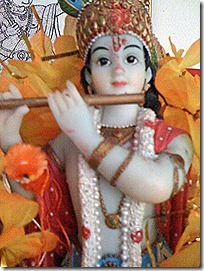 And what exactly is this method? The chanting of the holy names of the Lord, especially those found in the maha-mantra, “Hare Krishna Hare Krishna, Krishna Krishna, Hare Hare, Hare Rama Hare Rama, Rama Rama, Hare Hare”, brings the direct association of the Supreme Lord, as His name automatically evokes remembrance of His other names, forms, qualities and pastimes. As a distinct individual, though one having an inconceivable brilliance, God is ever given towards sportive exploits, and His land is full of variegatedness to a level unfathomable to the human mind. Therefore the wonderful qualities that correspond with these transcendental activities are limitless and the source of glorification. But the names “Rama” and “Krishna” best encapsulate the full breadth and scope of the Supreme Lord’s potencies. As Krishna, He is all-attractive and thus worthy of being worshiped by every single person. He has a beautiful body, a wonderful complexion, and emits sound vibrations with His flute that can mesmerize even the most dedicated fruitive worker, mental speculator, meditational yogi or grossly foolish servant of matter, one who completely denies the existence of God.
And what exactly is this method? The chanting of the holy names of the Lord, especially those found in the maha-mantra, “Hare Krishna Hare Krishna, Krishna Krishna, Hare Hare, Hare Rama Hare Rama, Rama Rama, Hare Hare”, brings the direct association of the Supreme Lord, as His name automatically evokes remembrance of His other names, forms, qualities and pastimes. As a distinct individual, though one having an inconceivable brilliance, God is ever given towards sportive exploits, and His land is full of variegatedness to a level unfathomable to the human mind. Therefore the wonderful qualities that correspond with these transcendental activities are limitless and the source of glorification. But the names “Rama” and “Krishna” best encapsulate the full breadth and scope of the Supreme Lord’s potencies. As Krishna, He is all-attractive and thus worthy of being worshiped by every single person. He has a beautiful body, a wonderful complexion, and emits sound vibrations with His flute that can mesmerize even the most dedicated fruitive worker, mental speculator, meditational yogi or grossly foolish servant of matter, one who completely denies the existence of God.Rama is the name and form especially dear to Tulsidas. This wonderful name describes the Lord’s ability to provide transcendental pleasure to others, and it is also used to address His incarnation as the prince of the Raghu dynasty, Shri Ramachandra, who appears in each creation during the Treta Yuga to protect devotees, annihilate miscreants and reestablish the true principles of religion. Indeed, God even appears in the Kali Yuga, the present age, but in the form of the holy name to perform the exact same functions. With material advancement come new scientific theories and mentally concocted systems of maintenance. These are religions in their own right; except they have no authority nor have they passed any quality control tests. The authors of such theories are themselves wholly dedicated to matter, so they have failed to even surpass the animalistic mindset which bases identity solely off of bodily features which are ultimately subject to destruction. The body can never be used to form a lasting identity, because wherefrom did we get these material elements? Moreover, at what point did we become worthy of accepting the assigned identification? At the time of birth, a period in our life that we can’t even remember, our home was the body of a tiny infant. Yet would any of us go around today and refer to ourselves as babies? This means that the identity of the adult individual must be accepted at some point. But if something is accepted, it must also be renounced, as the nature of the interaction is asanatana, or not eternal.
Real religion must be eternal, for it is the discipline that corresponds with the nature of the soul, which itself is an eternally existing entity. The dharma of the soul, its primary characteristic, never changes, though the specific rules and regulations instituted to realize that characteristic may shift from time to time to suit the specific circumstances in society. The original system of dharma was passed down by God Himself at the beginning of creation through aural reception, but as time goes on, sometimes the system gets lost. Therefore the Lord personally descends to earth to reinstitute them, or sometimes He sends His authorized representative.
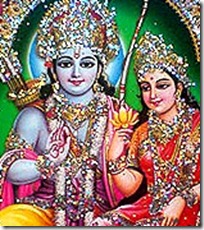 In this age, the holy name is the full incarnation, capable of performing the same feats that were enacted by the very personalities they address. This means that if we chant the name of Rama over and over again in a mood of love, we can get whatever we want. After all, if Rama is God, He can surely bring to us whatever we desire. But the name of Rama also reinstitutes dharma, for it allows the soul to gradually awaken its natural propensity, that of offering loving service to the Supreme Lord. In every sphere of life the serving propensity is witnessed. Even someone who is totally alone, without a wife or children, will purchase a dog or cat to take care of and give attention to. This shows that the inclination towards service must be acted upon, but that without knowledge of spirituality, the proper beneficiaries are never correctly identified.
In this age, the holy name is the full incarnation, capable of performing the same feats that were enacted by the very personalities they address. This means that if we chant the name of Rama over and over again in a mood of love, we can get whatever we want. After all, if Rama is God, He can surely bring to us whatever we desire. But the name of Rama also reinstitutes dharma, for it allows the soul to gradually awaken its natural propensity, that of offering loving service to the Supreme Lord. In every sphere of life the serving propensity is witnessed. Even someone who is totally alone, without a wife or children, will purchase a dog or cat to take care of and give attention to. This shows that the inclination towards service must be acted upon, but that without knowledge of spirituality, the proper beneficiaries are never correctly identified.“A living entity, by constitution, has the propensity to be attached to something. We see that if someone has no object of attachment, if he has no children, he transfers his attachment to cats and dogs. This indicates that the propensity for attachment cannot be stopped; rather, it must be utilized for the best purpose.” (Shrila Prabhupada, Teachings of Lord Kapila, Ch 10)
Chanting the name of Rama over and over is a direct form of service, as it allows the loving propensity to be directed towards a worthy object, the Supreme Lord, who surpasses all sectarian and sentimentalist boundaries. Even if one is of a different religious persuasion, the chanting of the holy names of the Lord is still open to them. Tulsidas says that Rama’s name is like a desire tree, one that fulfills every wish of the chanter. This may seem to raise a slight contradiction, as some desires can clash with others. For instance, if we wanted to rob a bank or cheat on a test, can we treat Rama’s name as our desire tree that will grant our wish?
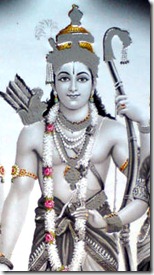 The point to understand about desire is that it is always rooted in meeting the ananda property of the soul. Just like their supreme father, every living entity is blissful by nature, but in the conditioned state, one bereft of God consciousness, the search for bliss leads to activities which are neither authorized nor capable of securing that happiness. Chanting Rama’s name, on the other hand, is completely spiritual, so even if one has ill motives in the beginning, through steady chanting the true desire of the soul can emerge. More than anything else, the devotee of Rama asks to be able to continue their chanting, as the name itself brings association with the Supreme Lord. Whatever favorable conditions are required for meeting the true desire of the soul will be granted by the wish-fulfilling tree that is Rama’s name.
The point to understand about desire is that it is always rooted in meeting the ananda property of the soul. Just like their supreme father, every living entity is blissful by nature, but in the conditioned state, one bereft of God consciousness, the search for bliss leads to activities which are neither authorized nor capable of securing that happiness. Chanting Rama’s name, on the other hand, is completely spiritual, so even if one has ill motives in the beginning, through steady chanting the true desire of the soul can emerge. More than anything else, the devotee of Rama asks to be able to continue their chanting, as the name itself brings association with the Supreme Lord. Whatever favorable conditions are required for meeting the true desire of the soul will be granted by the wish-fulfilling tree that is Rama’s name.Tulsidas also says that devotion to Rama, or Rama-bhakti, is like a celestial cow, or suradhenu. The cow is the most respected animal in the Vedic tradition because of what it offers to society. We take milk from our mother, so we respect her for the rest of our life. Similarly, we take milk from the cow, so we should respect her in the exact same way, giving her a status equal to our mother. The cow is also very easy to maintain and provides tremendous output as a result of a little care and concern. Though its milk is produced for its children, the output is so great that milk can be taken from the cow with plenty still left over for the calves. In this way the cow proves to be an engine of economic freedom, as simply owning a small plot of land and having a few cows are enough to provide a steady supply of food.
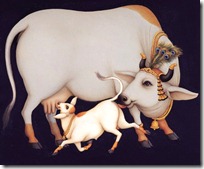 The cows in the heavenly realm, the place where the demigods, or suras, reside, are wonderful in every way. Similar to the kamataru, or wish-fulfilling tree, the celestial cow can provide anything to its owner. This is because the owner takes great care of it, giving total respect and honor to the cow who doesn’t ask for anything except protection. There was a famous meeting once between the venerable Vashishtha Muni and the sage Vishvamitra while he was still a king. Vishvamitra was a guest at Vashishtha’s cottage, and seeing Vashishtha’s wonderful cow that provided everything for Vishvamitra and his troops, Vishvamitra insisted on taking it for himself. As a brahmana, Vashishtha couldn’t fight back against the force applied by Vishvamitra, so he pleaded to the cow to help. The cow then produced all sorts of weapons and military fighters that helped Vashishtha fight off Vishvamitra’s attempt at theft.
The cows in the heavenly realm, the place where the demigods, or suras, reside, are wonderful in every way. Similar to the kamataru, or wish-fulfilling tree, the celestial cow can provide anything to its owner. This is because the owner takes great care of it, giving total respect and honor to the cow who doesn’t ask for anything except protection. There was a famous meeting once between the venerable Vashishtha Muni and the sage Vishvamitra while he was still a king. Vishvamitra was a guest at Vashishtha’s cottage, and seeing Vashishtha’s wonderful cow that provided everything for Vishvamitra and his troops, Vishvamitra insisted on taking it for himself. As a brahmana, Vashishtha couldn’t fight back against the force applied by Vishvamitra, so he pleaded to the cow to help. The cow then produced all sorts of weapons and military fighters that helped Vashishtha fight off Vishvamitra’s attempt at theft.Devotion to Rama is like the celestial cow, because having undying love for God can provide all benefits in life, just as the cow that is well protected continues to produce commodities. Indeed, devotion to Rama is the pinnacle of all religious practice, as other systems of spirituality are meant to lead to the platform of bhakti, or devotion. The dharma of the soul is to serve the Supreme Lord in this mood of love and devotion. So one who has reached this high platform, who keeps the flame of bhakti alive by regularly chanting Rama’s name, never has to worry about being poor, starving to death, or being without life’s essentials.
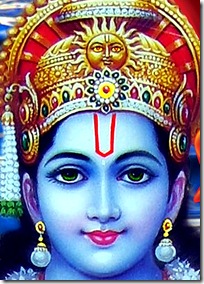 Yet, in this verse Tulsidas only sets the table with the first line. He opens by describing the end-goal, the tangible fruits that end up fulfilling desires and maintaining the flame of divine love within the soul. In the second part of the verse, however, the wonderful poet describes the source of these two boons. After all, the kamataru and suradhenu must come from somewhere. We can’t just will them to appear in front of us, nor can we mount an attack and steal these objects from some other place. There is only one way to find these fortunes, one method for acquiring the most wonderful fruits of life that then serve to meet the root desires of the soul. That path is to take the dust coming from the lotus feet of the guru.
Yet, in this verse Tulsidas only sets the table with the first line. He opens by describing the end-goal, the tangible fruits that end up fulfilling desires and maintaining the flame of divine love within the soul. In the second part of the verse, however, the wonderful poet describes the source of these two boons. After all, the kamataru and suradhenu must come from somewhere. We can’t just will them to appear in front of us, nor can we mount an attack and steal these objects from some other place. There is only one way to find these fortunes, one method for acquiring the most wonderful fruits of life that then serve to meet the root desires of the soul. That path is to take the dust coming from the lotus feet of the guru.The bona fide guru, or spiritual master, is himself ever devoted to Rama, or one of His non-different forms like Vishnu, Krishna,Narasimha, etc. The number of non-different forms of Godhead, which are referred to as vishnu-tattva, is so many that there are many avenues available to the sincere soul wishing to connect with God. Even those who worship a formless aspect of the Supreme Truth are devotees in one sense, though their interaction with the spiritual land is not personal. Therefore they too ascend to the spiritual realm after the present life is over, but they remain on the outskirts of the personal planets that make up the area known as Vaikuntha.
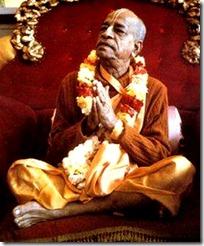 The guru spends his life devoted to Rama and preaching His glories. He never claims to be God, nor does he ever provide instructions aimed at furthering any end except full and complete surrender to the Lord, orsharanagati. In this way the guru can teach others by both instruction and personal example how to make the most out of life. The dust from the lotus feet of the guru is the most important reward in life, because by accepting such a gift, we can realize the proper mood with which to interact with spiritual guides. Challenging Rama’s devotees, arguing their every statement, and making their lives difficult are not pathways to success. Indeed, these tactics don’t work in any discipline of knowledge gathering. Just imagine what would have happened if we would have challenged every statement made by our math and reading teachers in our youth. We never would have learned anything. Surely as young children we would have thought that the teacher was crazy and unintelligent, but what did we know any way?
The guru spends his life devoted to Rama and preaching His glories. He never claims to be God, nor does he ever provide instructions aimed at furthering any end except full and complete surrender to the Lord, orsharanagati. In this way the guru can teach others by both instruction and personal example how to make the most out of life. The dust from the lotus feet of the guru is the most important reward in life, because by accepting such a gift, we can realize the proper mood with which to interact with spiritual guides. Challenging Rama’s devotees, arguing their every statement, and making their lives difficult are not pathways to success. Indeed, these tactics don’t work in any discipline of knowledge gathering. Just imagine what would have happened if we would have challenged every statement made by our math and reading teachers in our youth. We never would have learned anything. Surely as young children we would have thought that the teacher was crazy and unintelligent, but what did we know any way?The conditioned soul similarly has no clue what it takes to break free from the clutches of maya, or material existence, especially in her empowered form in the Kali Yuga. Therefore through humble submission to the guru, wherein hearing is given the most stress, the pathway to freedom can be found. Tulsidas accurately notes that the dust of the lotus feet of the guru is the source of all good fortune, sakala sumangala, because the guru brings about the two rewards mentioned previously. Chanting Rama’s name and devotion to the Lord are achieved only through the instruction of the guru, who advises everyone in this age to remain committed to bhakti through the different processes of chanting, hearing, remembering, worshiping, serving the lotus feet of the Lord, and other engagements. The human mind, through esoteric analysis, field study, scientific research, and the concoction of mental theories is never capable of reaching on its own the conclusion of the need for worshiping Rama. Rather, the mind is geared towards looking for every solution except bhakti.
 What if we never meet a guru? What if we never get the benediction of the dust of their lotus feet? The guru doesn’t necessarily have to be an established or recognized saint. Rather, anyone who sincerely chants the names of Krishna and Rama and makes devotion to the Lord their life’s occupation can immediately be considered a guru, for they teach by their very example. In addition, the words of the spiritual master are equally as effective as personal association. And in recent times celebrated Vaishnava acharyas have produced volumes upon volumes of literature glorifying the Supreme Lord and devotion to Him. The very songs and wonderful verses passed down by Goswami Tulsidas represent perfect instruction, thus making his statement above applicable to his own writings. Tulsidas glorifies Rama and His holy name, and in this way he becomes the most wonderful teacher, a kind saint who imbibes the sincere listener with devotion to Rama, the source of all blessings in both this life and the next.
What if we never meet a guru? What if we never get the benediction of the dust of their lotus feet? The guru doesn’t necessarily have to be an established or recognized saint. Rather, anyone who sincerely chants the names of Krishna and Rama and makes devotion to the Lord their life’s occupation can immediately be considered a guru, for they teach by their very example. In addition, the words of the spiritual master are equally as effective as personal association. And in recent times celebrated Vaishnava acharyas have produced volumes upon volumes of literature glorifying the Supreme Lord and devotion to Him. The very songs and wonderful verses passed down by Goswami Tulsidas represent perfect instruction, thus making his statement above applicable to his own writings. Tulsidas glorifies Rama and His holy name, and in this way he becomes the most wonderful teacher, a kind saint who imbibes the sincere listener with devotion to Rama, the source of all blessings in both this life and the next.Equal pay for equal work for migrant workers?
SUBMITTED BY SANKET MOHAPATRA
The recent negotiations between Philippines and Saudi Arabia about the minimum living wages for migrant workers have resulted in a stalemate. Philippines is demanding a minimum wage of $400 per month for its workers, while Saudi Arabia is willing to stipulate a minimum wage of $200 per month. Saudi Arabia stopped processing contracts of Filipino workers in March, recently the Philippines has said that it will not send Filipino maids to Saudi Arabia until the dispute is resolved. Saudi Arabia hosts 1.2 million Filipino migrantsand accounts for nearly 300,000 overseas deployments annually, while the Philippines receives $1.5 billion annually in remittances from Saudi Arabia. Thus, this wage dispute could lead to loss of employment opportunities for Filipinos, involve cost of reintegrating returning workers, and a reduction in remittance flows -- all of which could adversely impact the Philippine economy.
The minimum wage demanded by the Philippines government is a quarter of the average gross national income (GNI) per capita of Saudi Arabia, but higher than the average GNI per capita in the Philippines. The minimum wage that Saudi Arabia is willing to offer to migrant workers is just two-fifth of the income of a person at the poverty line in the United States (based on annual income for a family of four ) and almost a tenth of the minimum wage in New York state.
In the past, Saudi Arabia's labor minister has opined that Saudi Arabia's wages in the private sector were "a shame". These were linked to the presence of several million migrant workers willing to work for a low wage and also a reason for unemployment of a quarter million Saudi males, who presumably have a higher "reservation wage". Saudi Arabia is one of the few countries that does not have any minimum wages.
However, when markets are imperfect or segmented, there could be a role of minimum wages. Unskilled migrants from developing countries in the Gulf appear to be willing to work for far less than the average wages in a typical high income country, and at wages comparable to, or slightly higher, than their own countries’ incomes.
The market for unskilled international migrant workers may be characterized by the models of Arthur Lewis where a rural sector exists with an unlimited supply of labor willing to work for a low wage that is comparable to the wages in the rural sector. This plentiful supply of labor keeps the prevailing wage for migrants low in the destination regions.
There is another view which considers the concept of a “living wage” sufficient to provide a certain standard of living for the workers. However, this concept is subjective and subject to similar criticism as minimum wage - whether it could include just nutritional requirements, rent, living expenses, children's education etc.
Some questions for discussion:
1. Should there be a minimum wage for migrant workers on the basis of commonly accepted minimum standard of living?
2. Should the minimum wage for migrants be the same as for natives?
3. Will imposing a minimum wage that is higher than the currently prevailing wage reduce the demand for migrant workers and reduce remittance flows?
Caltech researchers increase the potency of HIV-battling proteins
Posted by Biomechanism
If one is good, two can sometimes be better. Researchers at the California Institute of Technology (Caltech) have certainly found this to be the case when it comes to a small HIV-fighting protein.
The protein, called cyanovirin-N (CV-N), is produced by a type of blue-green algae and has gained attention for its ability to ward off several diseases caused by viruses, including HIV and influenza. Now Caltech researchers have found that a relatively simple engineering technique can boost the protein’s battling prowess.
Daniel Kavanagh of Massachusetts General Hospital in the U.S. will test a class of molecular probes for their ability to identify cells latently infected with HIV. If successful, these probes could be used to target and eliminate these HIV-infected cells.
“By linking two cyanovirins, we were able to make significantly more potent HIV-fighting molecules,” says Jennifer Keeffe, a staff scientist at Caltech and first author of a new paper describing the study in the Proceedings of the National Academy of Sciences (PNAS). “One of our linked molecules was 18 times more effective at preventing infection than the naturally occurring, single protein.”
The team’s linked pairs, or dimers, were able to neutralize all 33 subtypes of HIV that they were tested against. The researchers also found the most successful dimer to be similar or more potent than seven well-studied anti-HIV antibodies that are known to be broadly neutralizing.
CV-N binds well to certain carbohydrates, such as the kind found in high quantities connected to the proteins on the envelope that surrounds the HIV virus. Once attached, CV-N prevents a virus from infecting cells, although the mechanism by which it accomplishes this is not well understood.
What is known is that each CV-N protein has two binding sites where it can bind to a carbohydrate and that both sites are needed to neutralize HIV.
Once the Caltech researchers had linked two CV-Ns together, they wanted to know if the enhanced ability of their engineered dimers to ward off HIV was related to the availability of additional binding sites. So they engineered another version of the dimers—this time with one or more of the binding sites knocked out—and tested their ability to neutralize HIV.
It turns out that the dimers’ infection-fighting potency increased with each additional binding site—three sites are better than two, and four are better than three. The advantages seemed to stop at four sites, however; the researchers did not see additional improvements when they linked three or four CV-N molecules together to create molecules with six to eight binding sites.
Although CV-N has a naturally occurring dimeric form, it isn’t stable at physiological temperatures, and thus mainly exists in single-copy form. To create dimers that would be stable under such conditions, the researchers covalently bound together two CV-N molecules in a head-to-tail fashion, using flexible polypeptide linkers of varying lengths.
Interestingly, by stabilizing the dimers and locking them into a particular configuration, it seems that the group created proteins with distances between binding sites that are very similar to those between the carbohydrate binding sites in a broadly neutralizing anti-HIV antibody.
“It is possible that we have created a dimer that has its carbohydrate binding sites optimally positioned to block infection,” says Stephen Mayo, Bren Professor of Biology and Chemistry, chair of the Division of Biology, and corresponding author of the new paper.
Because it is active against multiple disease-causing viruses, including multiple strains of HIV, CV-N holds unique promise for development as a drug therapy. Other research groups have already started investigating its potential application in prophylactic gels and suppositories.
“Our hope is that those who are working to make prophylactic treatments using cyanovirin will see our results and will use CVN2L0 instead of naturally occurring cyanovirin,” Keeffe says. “It has higher potency and may be more protective.”
___________________
The paper, entitled “Designed oligomers of cyanovirin-N show enhanced HIV neutralization,” was published in the online edition of PNAS. In addition to Keeffe and Mayo, other authors on the paper include research technician Priyanthi N.P. Gnanapragasam, former biology graduate student Sarah K. Gillespie, biology graduate student John Yong, and Pamela J. Bjorkman, the Max Delbruck Professor of Biology at Caltech and a Howard Hughes Medical Institute investigator.
The work was funded by the National Security Science and Engineering Faculty Fellowship program, the Defense Advanced Research Projects Agency Protein Design Processes program, and the Bill and Melinda Gates Foundation through the Grand Challenges in Global Health Initiative.
Cancer researchers look to dogs to better understand intricacies of bone cancer
Posted by Biomechanism
CANCER RESEARCH: A team led by Dr. Jaime Modiano, a College of Veterinary Medicine and Masonic Cancer center expert in comparative medicine, discovered a gene pattern that distinguishes the more severe form of bone cancer from a less aggressive form in dogs. Dogs are the only other species besides humans that develops this disease spontaneously with any frequency.
Dogs are much more likely to develop bone cancer than humans, but according to Modiano – who specializes in the relationship between animal and human disease – human and canine forms of bone cancer are very similar and the gene pattern is an exact match.
“Our findings pave the way to develop laboratory tests that can predict the behavior of this tumor in dogs and children at the time of diagnosis,” said Dr. Jaime Modiano, College of Veterinary Medicine and Masonic Cancer Center expert in comparative medicine. “This allows us to tailor individualized therapy to meet the patient’s needs.”
“Patients with less aggressive disease could be treated conservatively, reducing the side effects and the risks associated with treatment, while patients with more aggressive disease could be treated with more intense therapy,” said Modiano.
This new University of Minnesota discovery may help bone cancer patients fight their disease more effectively, according to new research published in the September issue of Bone.
Bone cancer typically affects children; the course and aggressiveness of the disease can vary from patient to patient and is very difficult to predict. Some patients respond remarkably well to conventional therapies. Their disease shows less aggressive behavior and they can survive for decades without recurrence. Others respond poorly to treatment or their disease comes back rapidly. Often, these patients survive less than five years.
Recently, a team led by Dr. Jaime Modiano, a College of Veterinary Medicine and Masonic Cancer Center expert in comparative medicine, discovered a gene pattern that distinguishes the more severe form of bone cancer from a less aggressive form in dogs. Dogs are the only other species besides humans that develops this disease spontaneously with any frequency.
In fact, dogs are much more likely to develop bone cancer than humans, but according to Modiano – who specializes in the relationship between animal and human disease – human and canine forms of bone cancer are very similar and the gene pattern is an exact match. The discovery of this key differentiating signature may be beneficial in the treatment planning of human bone cancer patients.
“Our findings pave the way to develop laboratory tests that can predict the behavior of this tumor in dogs and children at the time of diagnosis,” said Modiano. “This allows us to tailor individualized therapy to meet the patient’s needs.”
The downstream impact of the findings
University of Minnesota researchers hope to use their findings to develop practical and useful lab tests for humans and for companion animals that will help clinical care providers determine the type of cancer a patient faces, and how aggressive that cancer may be.
Then, depending on which type of cancer a patient has, clinicians could adjust interventions and treatment plans accordingly.
“Patients with less aggressive disease could be treated conservatively, reducing the side effects and the risks associated with treatment, while patients with more aggressive disease could be treated with more intense therapy,” said Modiano.
The study was funded by the National Cancer Institute, the AKC Canine Health Foundation and the Kate Koogler Canine Cancer Fund.
Subscribe to:
Posts (Atom)